This chapter is about setting up your development environment, understanding the similarities and differences between .NET Core, .NET Framework, and .NET Native, and using various tools to create the simplest application possible with C#.
Most people learn complex topics by imitation and repetition rather than reading a detailed explanation of theory. So, I will not explain every keyword and step. The idea is to get you to write some code, build an application, and see it run. You don't need to know the details of how it all works yet.
In the words of Samuel Johnson, author of the English dictionary of 1755, I have likely committed "a few wild blunders, and risible absurdities, from which no work of such multiplicity is free." I take sole responsibility for these and hope you appreciate the challenge of my attempt to "lash the wind" by writing this book about .NET Core 1.0 during its rocky birth in the early months of 2016.
This chapter covers the following topics:
Setting up your development environment
Understanding the .NET Framework, .NET Core, and .NET Native
Writing and compiling code by using the Developer Command Prompt
Writing and compiling code by using Microsoft Visual Studio 2015
Targeting the .NET Core
Managing source code with GitHub
Before you start programming, you will need to set up your Interactive Development Environment (IDE) that includes a code editor for C#. The best IDE to choose is Microsoft Visual Studio 2015, but it only runs on the Windows operating system.
There are alternative IDEs for C#, for example, MonoDevelop, JetBrains Project Rider, and Microsoft Visual Studio Code. They each have versions available for Windows, Linux, and Mac OS X, allowing you to write code on one operating system and deploy to the same, or a different, one:
For MonoDevelop IDE, visit http://www.monodevelop.com/
For JetBrains Project Rider, visit http://blog.jetbrains.com/dotnet/2016/01/13/project-rider-a-csharp-ide/
For Microsoft Visual Studio Code, visit https://code.visualstudio.com/
Cloud9 is a web browser-based IDE, so it's even more cross-platform than the others. here is the link:
https://c9.io/web/sign-up/free
In Chapter 15, Taking C# Cross-Platform, I will show you how to use Visual Studio Code running on Mac OS X to create an ASP.NET Core 1.0 web application that can be deployed to Windows, Mac OS X, or Linux operating systems, or to Docker containers.
You can use Windows 7 or later to complete most of the chapters in this book, but you will have a better experience if you use Windows 10.
Tip
If you don't have Windows, I recommend that you create a virtual machine (VM) to use for development. You can choose any cloud provider, but Microsoft Azure has preconfigured VMs that include properly licensed Windows and Visual Studio 2015. You only pay for the minutes your VM is running, so it is a way for users of Linux, Mac OS X, and older Windows versions to have all the benefits of using Visual Studio 2015. Refer to Appendix B, Creating a Virtual Machine for Your Development Environment for more information.
Since October 2014, Microsoft has made a professional-quality edition of Visual Studio available to everyone for free. It is called the Community Edition.
Download and install Microsoft Visual Studio Community 2015 with Update 1 or higher.
If you prefer a smaller, faster installation then choose Default because it only requires 8 GB and should complete the installation in about an hour. With this choice, as shown in the following screenshot, you will be able to complete the first two-thirds of this book. To complete the rest of the book, you can later add additional features, such as support for building Universal Windows Platform (UWP) apps, via Programs and Features in the Control Panel:
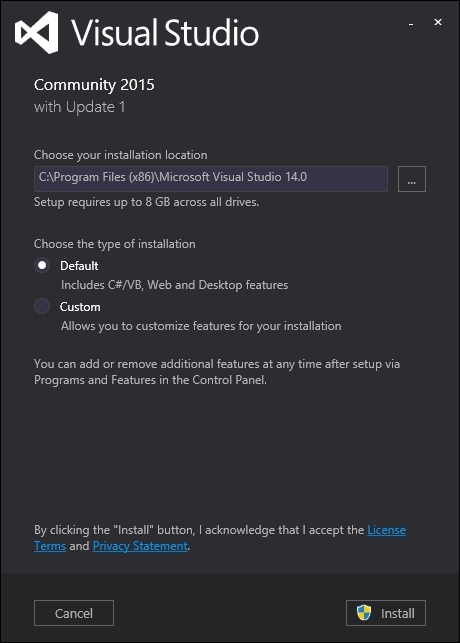
If you chose Default, then skip to the Completing the Installation section.
If you have 34 GB of free disk space and can wait for several hours, then in the installation dialog, choose Custom, and then click on Next. Select the following features:
Under Windows and Web Development, tick the following checkboxes:
Microsoft SQL Server Data Tools
Microsoft Web Developer Tools
Universal Windows App Development Tools
Under Cross Platform Mobile Development, tick the following checkbox:
C#/.NET (Xamarin)
Under Common Tools, tick the following checkboxes:
Git for Windows
GitHub Extension for Visual Studio
Click on Next:
Note
If you have the Home edition of Windows 10, then you will not be able to install emulators for Windows Phone because they require Hyper-V support.
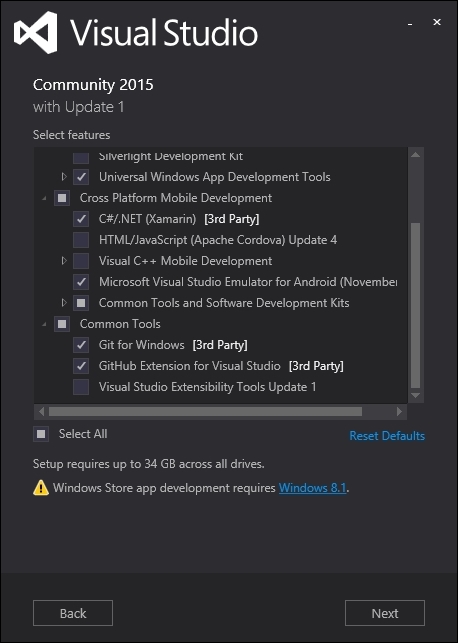
The first time that you run Visual Studio, you will be prompted to sign in:
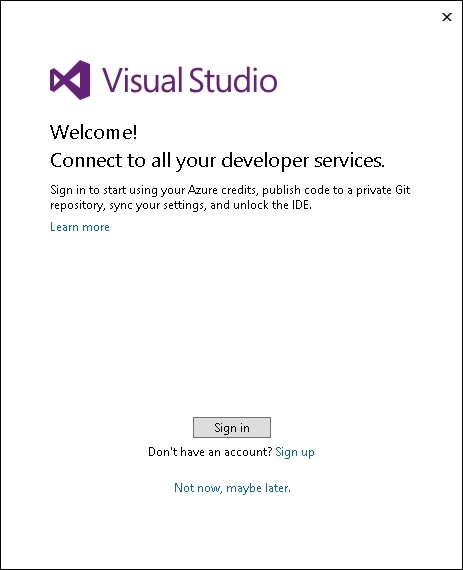
If you have a Microsoft account, for example, a Hotmail, MSN, Live, or Outlook e-mail address, you can use that account. If you don't, then register for a new one at the following link:
After signing in, you will be prompted to choose Development Settings. Choose Visual C# to configure keyboard shortcuts and a default window layout that works best for C# programmers, as shown in the following screenshot:
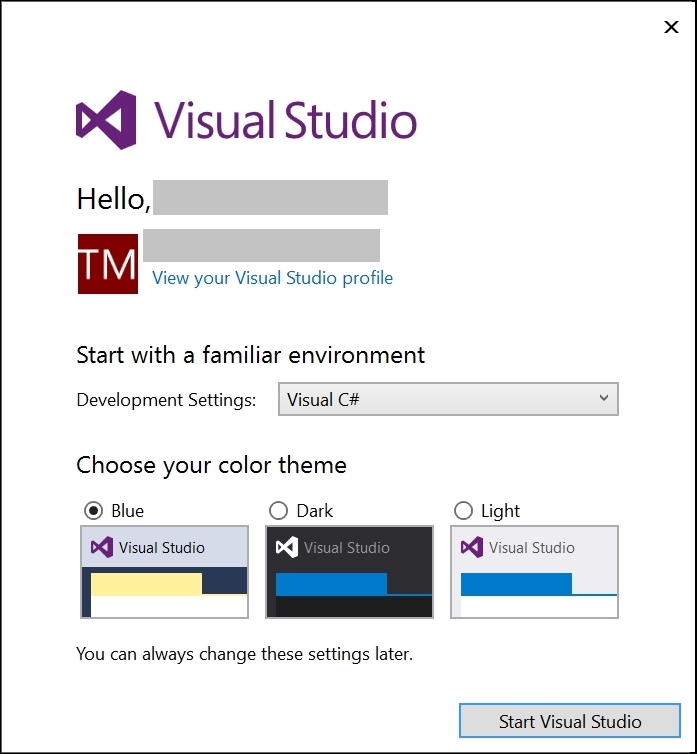
After you click on Start Visual Studio, you will see the Visual Studio user interface with the Start Page open in the central area. Like most Windows desktop applications, Visual Studio has a menu bar, a toolbar for common commands, and a status bar at the bottom. On the right is the Solution Explorer window that will list all of your open projects, as shown in the following screenshot:
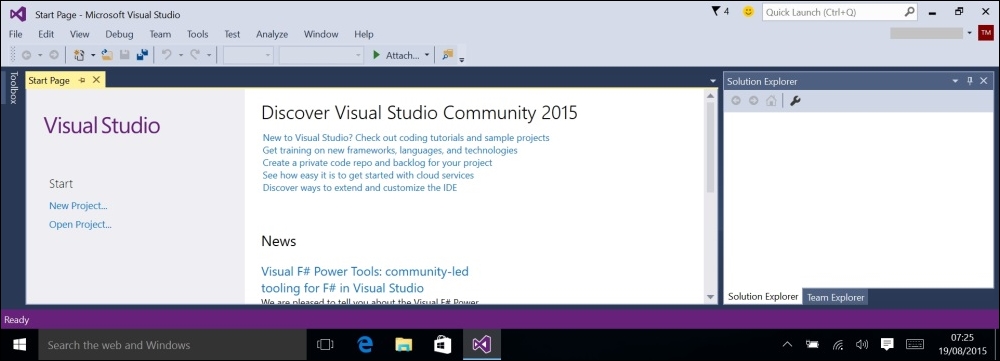
To have quick access to Visual Studio in the future, right-click on its entry in the Windows taskbar and select Pin this program to taskbar:
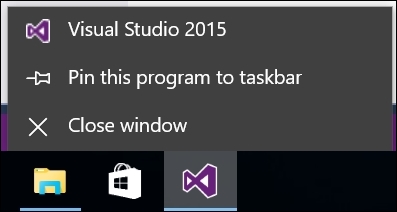
In the top-right corner of Visual Studio, you will see a flag that has a number next to it. These are notifications of extensions and product updates.
Click on the flag to display the Notifications window, as shown in the following screenshot:
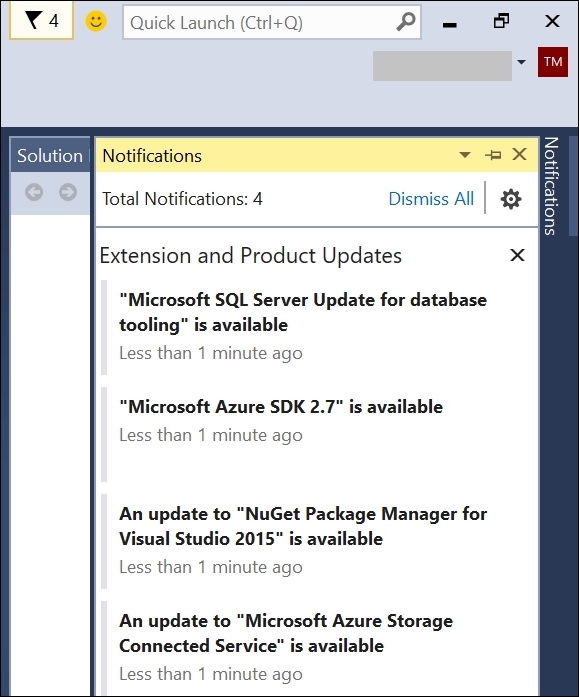
In the Notifications window, click on each entry to install the update. You can install these updates at a later time if you prefer, but it is best to keep your software up-to-date to avoid bugs and security holes. The following screenshot shows an extension downloading and installing:

If you want to use a free version of Visual Studio older than 2015, then you can use one of the more limited Express editions. A lot of the code in this book will work with older versions if you bear in mind when the following features were introduced:
|
Year |
C# |
Features |
|---|---|---|
|
2005 |
2 |
Generics with |
|
2008 |
3 |
Lambda expressions with |
|
2010 |
4 |
Dynamic typing with |
|
2012 |
5 |
Simplifying multithreading with |
|
2015 |
6 |
|
.NET Framework, .NET Core, and .NET Native are related platforms for developers to build applications and services upon.
Microsoft's .NET Framework is a development platform that includes a Common Language Runtime (CLR) that manages the execution of code and a rich library of classes for building applications.
Microsoft designed the .NET Framework to have the possibility of being cross-platform, but Microsoft put their implementation effort into making it work best with Windows.
Practically speaking, the .NET Framework is Windows-only.
The open source community developed a cross-platform .NET implementation named the Mono project (http://www.mono-project.com/).
Mono is cross-platform, but it fell well behind Microsoft's implementation of .NET Framework. It has found a niche as the foundation of the Xamarin mobile platform.
Today, we live in a truly cross-platform world. Modern mobile and cloud development have made Windows a much less important operating system. So, Microsoft has been working on an effort to decouple the .NET Framework from its close ties with Windows.
While rewriting .NET to be truly cross-platform, Microsoft has taken the opportunity to refactor .NET, to remove major parts that are no longer considered "core".
This new product is branded as the .NET Core 1.0, which includes a cross-platform implementation of the CLR, known as CoreCLR , and a streamlined library of classes known as CoreFX.
.NET Core 1.0 is much smaller than the current version of the .NET Framework because a lot has been removed.
For example, Windows Forms and Windows Presentation Foundation (WPF) can be used to build graphical user interface (GUI) applications, but they are tightly-bound to Windows, so they have been removed from the .NET Core. The latest technology for building Windows apps is the Universal Windows Platform (UWP). You will learn about it in Chapter 13, Building Universal Windows Platform Apps Using XAML.
ASP.NET Web Forms and Windows Communication Foundation (WCF) are old web applications and service technologies that fewer developers choose to use today, so they have also been removed from the .NET Core. Instead, developers prefer to use ASP.NET MVC and ASP.NET Web API. These two technologies have been refactored and combined into a new product that runs on the .NET Core, named ASP.NET Core 1.0. You will learn about it in Chapter 14, Building Web Applications and Services Using ASP.NET Core.
The Entity Framework (EF) 6.x is an object-relational mapping technology for working with data stored in relational databases, such as Oracle and Microsoft SQL Server. It has gained baggage over the years, so the cross-platform version has been slimmed down and named Entity Framework Core 1.0. You will learn about it in Chapter 8, Working with Relational Data Using the Entity Framework.
Some data types in .NET that are included with both the .NET Framework and the .NET Core have been simplified by removing some members. For example, in the .NET Framework, the File class has both a Close and Dispose method, and either can be used to release the file resources. In .NET Core, there is only the Dispose method. This reduces the memory footprint of the assembly and simplifies the API.
Tip
The .NET Framework 4.6 is about 200 MB. The .NET Core 1.0 is about 11 MB. Eventually, the .NET Core may grow to a similar larger size. Microsoft's goal is not to make the .NET Core smaller than the .NET Framework. The goal is to componentize .NET Core to support modern technologies and to have fewer dependencies so that deployment requires only those components that your application really needs.
The .NET Core is the future of .NET, but in my opinion, we are not there yet. .NET Core 1.0 is a great start, but it will take another version or two to become as mature as the current version of the .NET Framework.
This book will focus features available in .NET Core, but will use the .NET Framework when features have not (yet) been implemented in the .NET Core.
Another .NET initiative is .NET Native which compiles C# code to native CPU instructions ahead-of-time (AoT) rather than using the CLR to compile IL just-in-time (JIT) to native code later.
The .NET Native compiler improves execution speed and reduces the memory footprint for applications. It supports the following:
UWP apps for Windows 10, Windows 10 Mobile, Xbox One, HoloLens, and Internet of Things (IoT) devices such as Raspberry Pi
Server-side web development with ASP.NET Core 1.0
Console applications for use on the command line
The following table summarizes and compares Microsoft's three .NET technologies:
|
Platform |
Feature set |
C# compiles to |
Host OSes |
|---|---|---|---|
|
.NET Framework |
Mature and extensive |
Intermediate Language (IL) code |
Windows only |
|
.NET Core |
Brand-new and somewhat limited |
Windows, Linux, Mac OS X, Docker | |
|
.NET Native |
Brand-new and very limited |
Native code |
When you install Visual Studio, other tools are installed too. One of those tools is the Developer Command Prompt for VS2015 that has its path set to find developer tools such as the C# compiler.
Start Notepad (or your favorite text editor) and enter the following code:
class Program { static void Main() { System.Console.
WriteLine("Hello C#!"); } }You can type the code all on one line or spread it out over multiple lines and indent your lines to make it easier to read.
Note
C# is case sensitive, meaning that you must type uppercase and lowercase characters exactly as shown in the preceding code. C# is not whitespace sensitive, meaning that it does not care if you use tabs and spaces and carriage-returns to lay out your code however you like.
From the File menu, choose Save As.
In the dialog box, change to drive C: (or any drive that you want to use to save your projects), click on the New Folder button, and name the folder Code.
In the Save as type field, select All Files from the drop-down list to avoid appending the .txt file extension, and enter the file name as myfirstapp.cs, as shown in the following screenshot:
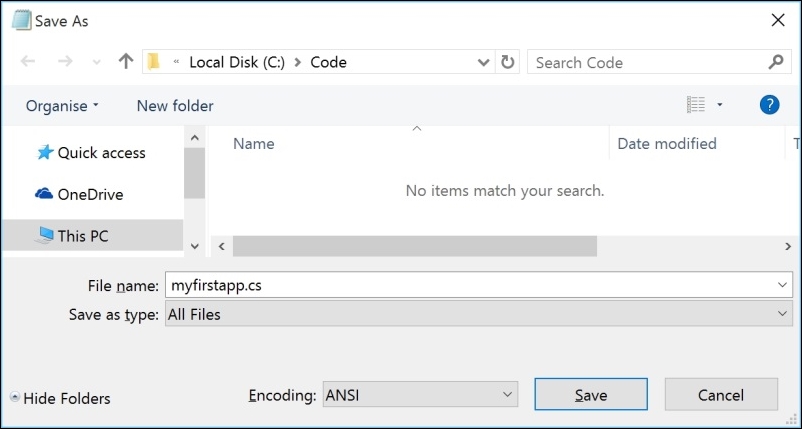
Your code in Notepad should look something like the following screenshot:

Start the Developer Command Prompt for VS2015 by typing the letters deve in the Windows 10 Search box, as you can see in the following screenshot. You will also find it on the Start Menu or Start Screen listed in All apps in the Visual Studio 2015 folder:
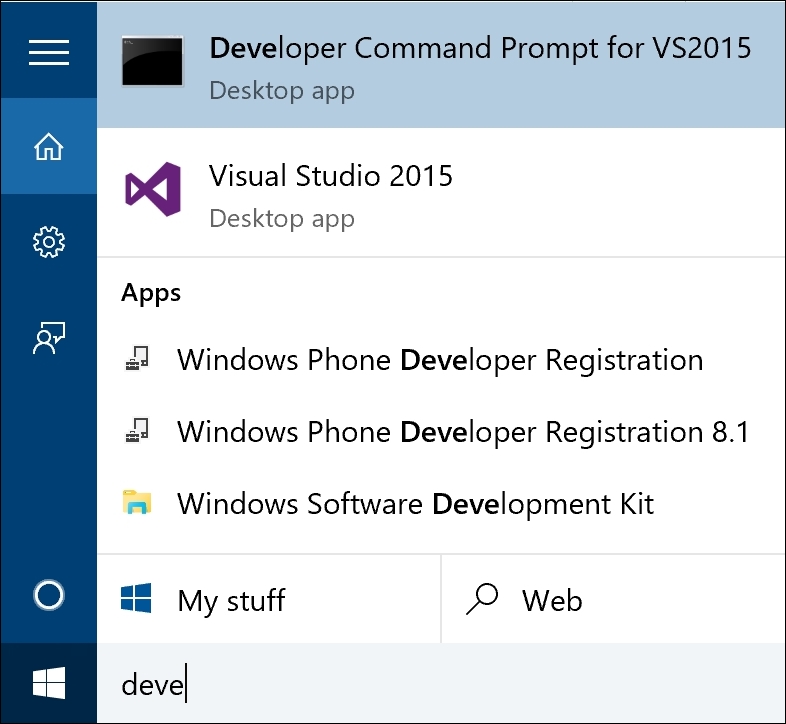
At the Command Prompt, enter the commands to do the following:
Change to the
C:\CodefolderCompile the source code using the C# compiler
Request a directory listing
Run the application by entering the name of the EXE
Here are the commands:
cd C:\Code csc myfirstapp.cs dir myfirstapp
The output in the Command Prompt window should look like this:
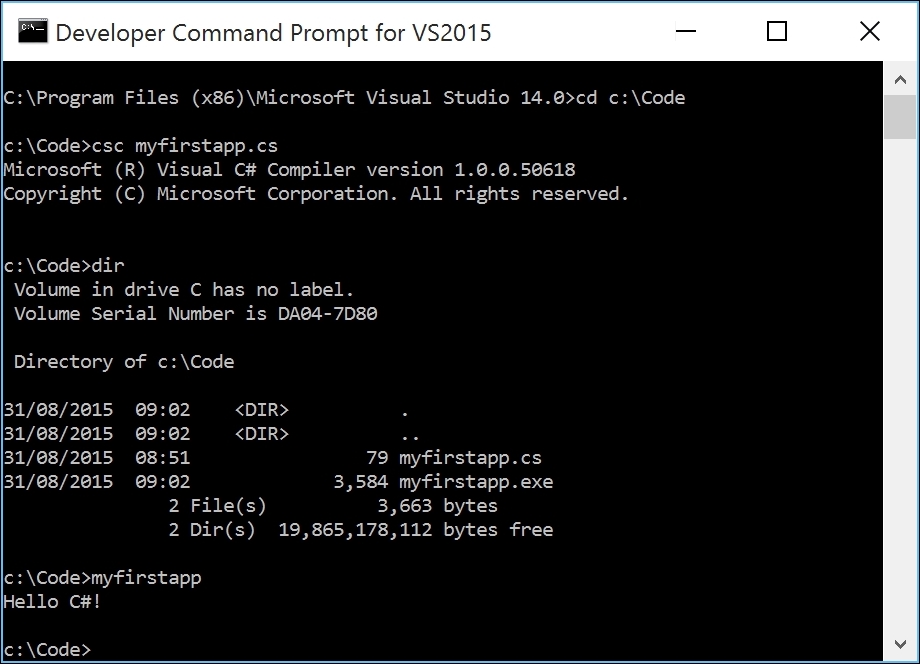
Note that your source code, the file named myfirstapp.cs, has been compiled into an assembly named myfirstapp.exe. When you enter the name of the assembly, it is loaded and executed by .NET Framework 4.6 and its CLR.
You can copy the myfirstapp.exe file onto any computer with Windows 10 and it will run correctly because all copies of Windows 10 have .NET Framework 4.6 installed. Actually, you can copy the file onto a computer with an older version of Windows as long as it has .NET Framework 4.0 or later installed.
If the compiler displays errors, read them carefully, and fix them in Notepad. Save your changes and recompile.
Tip
At the Command Prompt, you can press the up and down arrows on your keyboard to cycle through previous commands you have entered.
A typical error might be using the wrong case, a missing semi-colon at the end of a line, or a mismatched pair of curly braces. For example, if you had mistyped a lowercase m for the Main method you would see this error message:
error CS5001: Program does not contain a static 'Main' method suitable for an entry point
The C# compiler converts your source code into Intermediate Language (IL) code and stores the IL in an assembly (a DLL or EXE file).
IL code statements are like assembly language instructions, but they are executed by the .NET virtual machine known as the Common Language Runtime (CLR).
At runtime, the CLR loads the IL code from the assembly, JIT compiles it into native CPU instructions, and then it is executed by the CPU on your machine.
The benefit of this two-step compilation process is that Microsoft can create CLRs for Linux and Mac OS X as well as for Windows. The same IL code runs everywhere because of the second compilation process that generates code for the native operating system and CPU instruction set.
Regardless of which language the source is written in, all .NET applications use IL code for their instructions, stored in an assembly. Microsoft provides a tool that can open an assembly and reveal this IL code.
Disassembling a compiled assembly is an advanced technique. I will walk you through the process, but do not worry about fully understanding what you are seeing yet!
Start the IL Disassembler by entering the following at the Developer Command Prompt:
ildasm myfirstapp.exe
You will see the IL DASM tool with the compiled EXE assembly loaded:
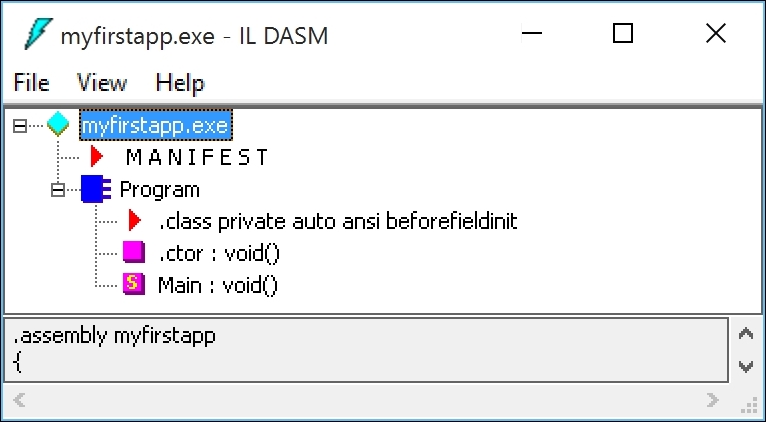
Double-click on
MANIFEST in the tree view to show the metadata version (4.0.30319) of .NET and the Microsoft Core Library (mscorlib) assembly version (4.0.0.0) that this assembly needs to run. The following screenshot tells us that to run this assembly, we would need .NET Framework 4.0 or later installed:
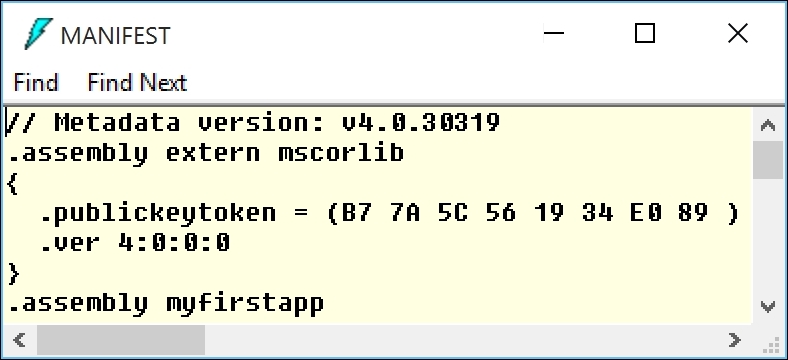
Close the MANIFEST window, expand Program, and then double-click on the Main method. Note the IL instructions: ldstr (load string), nop (no operation), and ret (return). Remember that IL is an assembly language that is executed by the .NET CLR:
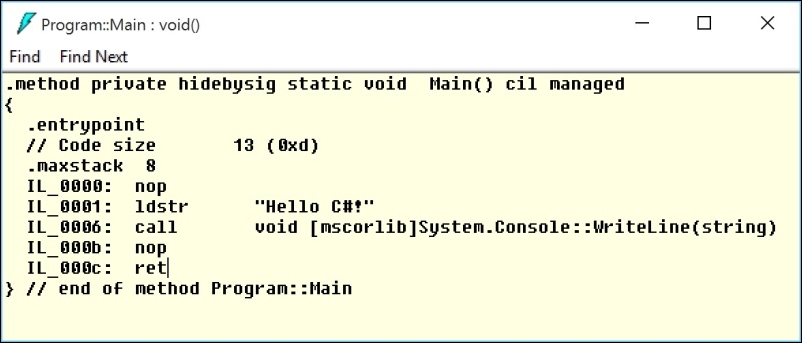
Anyone can use this tool to see any .NET assembly's IL code. Don't panic! This is not a reason to avoid C#.
All applications are lists of instructions that must be visible to the machine that runs it. If the machine can read these instructions, so can anything else. Therefore, all software can be reverse-engineered. It's just a matter of the effort required. .NET just happens to make it very easy!
We will now recreate the same application using Microsoft Visual Studio 2015.
I have been training students to use Visual Studio for over a decade, and I am always surprised at how many programmers fail to use the tool to their advantage.
Over the next few pages, I will slowly walk you through typing a line of code. It may seem redundant, but you will benefit from seeing what help and information Visual Studio provides as you enter your code. If you want to become a fast, accurate coder, letting Visual Studio write most of your code for you is a huge benefit!
Start Microsoft Visual Studio 2015.
Navigate to File | New | Project menu or press Ctrl + Shift + N.
At the top of the New Project dialog box, choose .NET Framework 4.6.1 (or later). From the Installed Templates list on the left, choose Visual C#. In the list at the center, choose Console Application. Enter the name Ch01_MyFirstApp, set the location to C:\Code, enter Chapter01 as the solution name, and click on OK or press Enter:
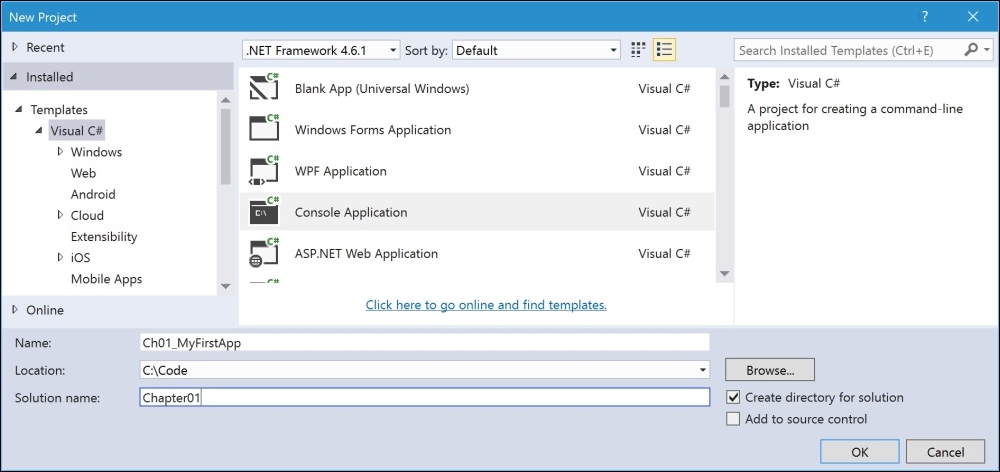
In the code editor, inside the Main method, press Enter to insert a new line between the innermost braces { }, and then type the letters sy, as you can see in the following screenshot:

Note that IntelliSense shows a list of keywords, namespaces, and types that contain the letters sy, and highlights the first one that starts with sy, which happens to be the namespace that we want—System.
Type a dot (also known as decimal point or full stop). IntelliSense automatically completes the word System for you, enters the dot, and displays a list of types and namespaces, such as AccessViolationException and Action, in the System namespace, as shown in the following screenshot:

Type the letters con and IntelliSense shows a list of matching types and namespaces:
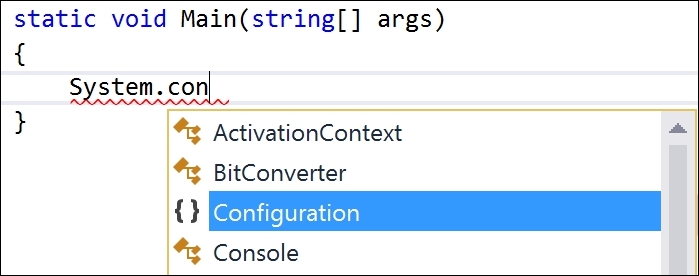
Press the down arrow on your keyboard to highlight Console, and then type a dot.
IntelliSense shows a list of the members of the Console class:

Tip
Members include properties (attributes of an object, such as BackgroundColor), methods (actions the object can perform, such as Beep), and other related things.
Type the letters wr. IntelliSense shows two matching members containing these letters:

Use the down arrow to highlight WriteLine and then type an open parenthesis (.
IntelliSense autocompletes WriteLine and enters a pair of parentheses.
You will also see a tooltip telling you that the WriteLine method has 19 variations:

Type a double quote ("). IntelliSense enters a pair of double quotes for you and leaves the keyboard cursor in between them.
Type the text Hello C#!, as shown in the following screenshot:

The red squiggle at the end of the line indicates an error, because every C# statement must end in a semicolon. Move the cursor to the end of the line by pressing End, and type a semicolon to fix the error.
From the Debug menu, choose Start Without Debugging or press Ctrl + F5. Your completed application runs in a console window and closes when you press any key:

To save space and to make the output clearer, I will usually not include screenshots of output from console applications as I did previously. Instead, I will show the output like this:
Hello C#!
Let's make two deliberate errors.
Change the M of the Main method to the lowercase letter m.
Delete the e at the end of the method name WriteLine.
On the Build menu, choose Build Ch01_MyFirstApp or press Shift + F6.
After a few seconds, the status bar tells us that the build failed and the error list is activated. You can also view the error list by pressing Ctrl + W, E:

The Error List can be filtered to show Errors, Warnings, and informational Messages by clicking on the toggle buttons at the top of the window.
If an error shows the line number, for example Line 13 in the preceding screenshot, then you can double-click on the error to jump to the line causing the problem.
If it's a more general error, such as the missing Main method, the compiler can't tell you the line number. You might want a method named main as well as a method named Main (remember that C# is case sensitive so you're allowed to do that).
Fix the two (as shown in the preceding screenshot) errors before you continue. Note that the error list updates to show no errors.
Although Visual Studio has always had an Immediate window with limited REPL (read-eval-print loop) support, Visual Studio 2015 with Update 1 includes an enhanced window with full IntelliSense and color syntax code, named C# Interactive.
On the View menu, choose Other Windows, and then C# Interactive.
We will write some interactive code to download the About page from Microsoft's public website.
At the C# Interactive prompt, we will enter commands to do the following:
Reference the
System.Net.HttpassemblyImport the
System.Net.HttpnamespaceDeclare and instantiate an HTTP client variable
Set the client's base address to Microsoft's website
Wait asynchronously for a response to a GET request for the About page
Read the status code returned by the web server
Read the content type header
Read the contents of the HTML page as a string
Type each of the following commands after the > prompt and then press Enter:
> #r "System.Net.Http" > using System.Net.Http; > var client = new HttpClient(); > client.BaseAddress = new Uri("http://www.microsoft.com/"); > var response = await client.GetAsync("about"); > response.StatusCode OK > response.Content.Headers.GetValues("Content-Type") string[1] { "text/html" } > await response.Content.ReadAsStringAsync() "<!DOCTYPE html ><html xmlns:mscom=\"http://schemas.microsoft.com/CMSvNext\" xmlns:md=\"http://schemas.microsoft.com/mscom-data\" lang=\"en\" xmlns=\"http://www.w3.org/1999/xhtml\"><head><meta http-equiv=\"X-UA-Compatible\" content=\"IE=edge\" /><meta charset=\"utf-8\" /><meta name=\"viewport\" content=\"width=device-width, initial-scale=1.0\" /><link rel=\"shortcut icon\" href=\"//www.microsoft.com/favicon.ico?v2\" /><script type=\"text/javascript\" src=\"http://ajax.aspnetcdn.com/ajax/jQuery/jquery-1.7.2.min.js\">\r\n // Third party scripts and code linked to or referenced from this website are licensed to you by the parties that own such code, not by Microsoft. See ASP.NET Ajax CDN Terms of Use - http://www.asp.net/ajaxlibrary/CDN.ashx.\r\n </script><script type=\"text/javascript\" language=\"javascript\">/*<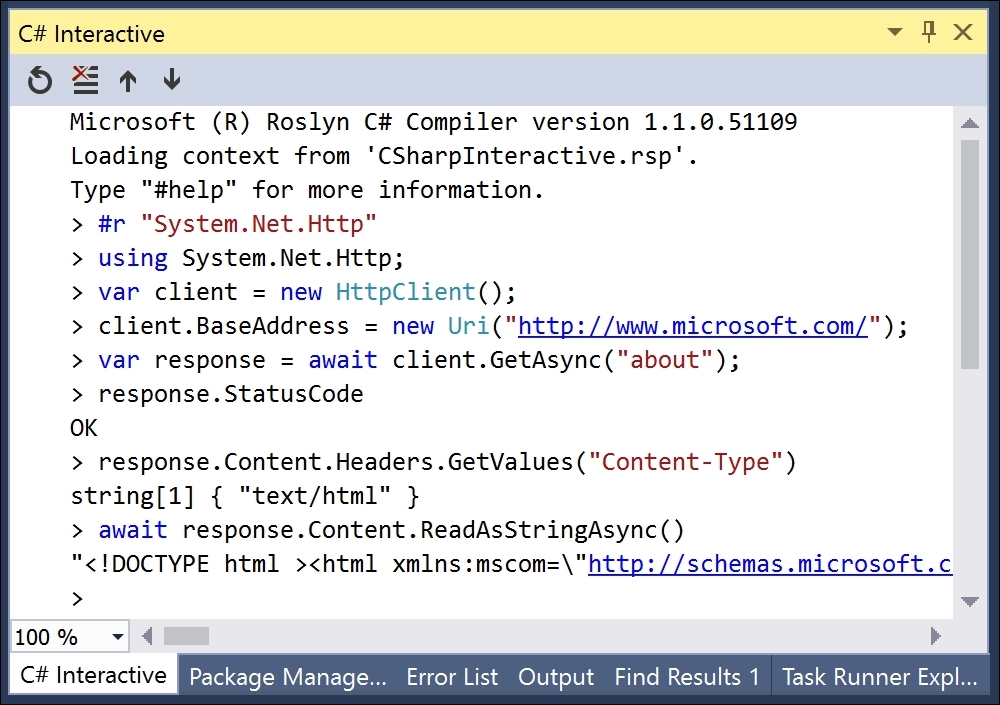
Visual Studio has lots of other useful windows, including the following:
If you ever can't see a window you need, go to the View menu to make it reappear or learn its keyboard shortcut, as shown here:
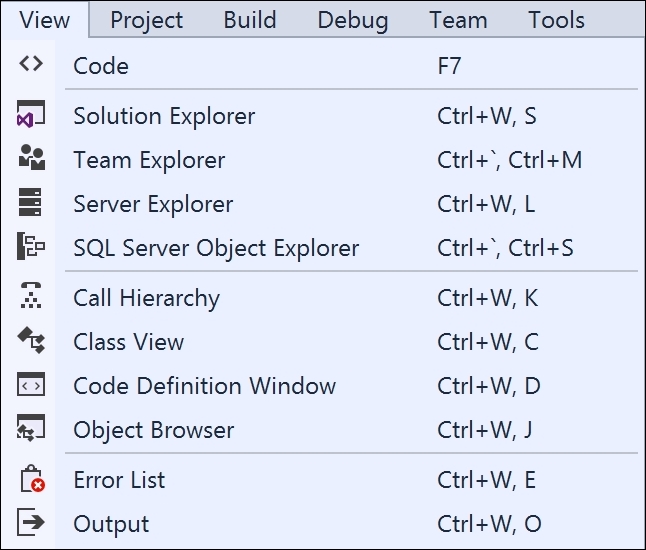
Tip
If your keyboard shortcuts are different from the ones in the preceding screenshot, it is because you picked a different set when you installed Visual Studio. You can reset your keyboard shortcuts to match the ones used in this book by clicking on the Tools menu, then clicking on Import and Export Settings…, choosing Reset all settings, and then choosing to reset to the Visual C# settings collection.
For 15 years, .NET programmers have been targeting the .NET Framework, so there are many projects that may need to move from Windows-only to cross-platform by retargeting to the .NET Core.
To ensure that a project will work cross-platform, we can install and run the Visual Studio 2015 extension named .NET Portability Analyzer.
It allows you to choose multiple platforms that you would like to target and then scans your compiled assemblies, passes a list of the types and methods that you use to a web service, and produces a report that lists which ones are not supported on each platform along with recommendations for fixes.
In Visual Studio, go to the Tools menu and choose Extensions and Updates….
On the left-hand side of the dialog, click on Online. In the Search Visual Studio Gallery box, type portability and press Enter.
Click on the .NET Portability Analyzer entry and then click on the Download button. Once the extension is installed, restart Visual Studio:

In Visual Studio, go to the Tools menu and choose Options.
In the Options dialog box, scroll down through the left-hand side list and choose .NET Portability Analyzer. In the Target Platforms section, deselect everything except for the following:
.NET Core (Cross-platform) 1.0 (shown as 5.0 in the following screenshot)
.NET Framework 4.5
.NET Native 1.0
ASP.NET Core 1.0 (shown as ASP.NET 5 in the screenshot below):
Tip
Microsoft Azure has a Platform-as-a-Service (PaaS) feature named Cloud Services, which is limited to the .NET Framework 4.5; this is why it is a common target platform to check with the analyzer.
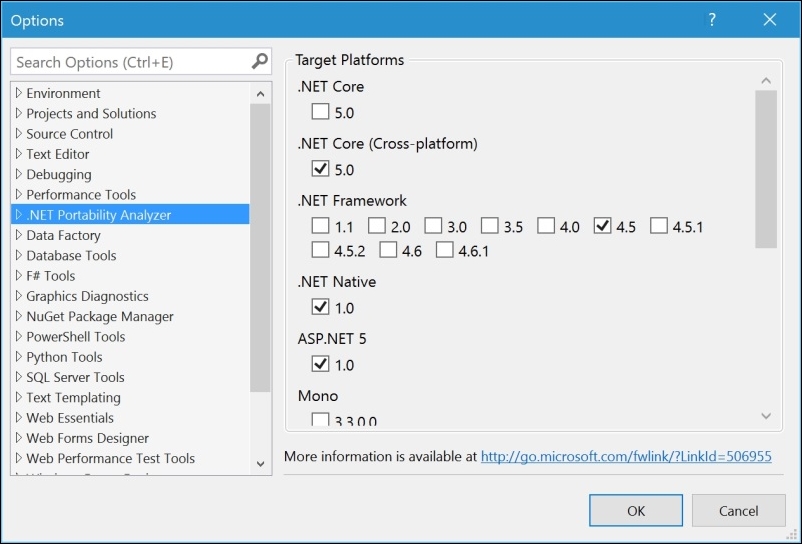
In Visual Studio, open the previous solution, named Chapter01. In the Solution Explorer window, right-click on the project named Ch01_MyFirstApp (not the solution), choose Analyze, and then choose Analyze Assembly Portability.
After a few seconds, a report will display in the main area.
Tip
Be patient with the .NET Portability Analyzer because it has to send data to a web service and wait for a response.
Note that the Console class in the System namespace and its WriteLine method are supported by the following:
.NET Core (Cross-Platform) 1.0 (shown as 5.0 in the following screenshot)
.NET Framework 4.5
ASP.NET Core 1.0 (shown as ASP.NET 5 in the following screenshot)
However, it is not supported by .NET Native 1.0:
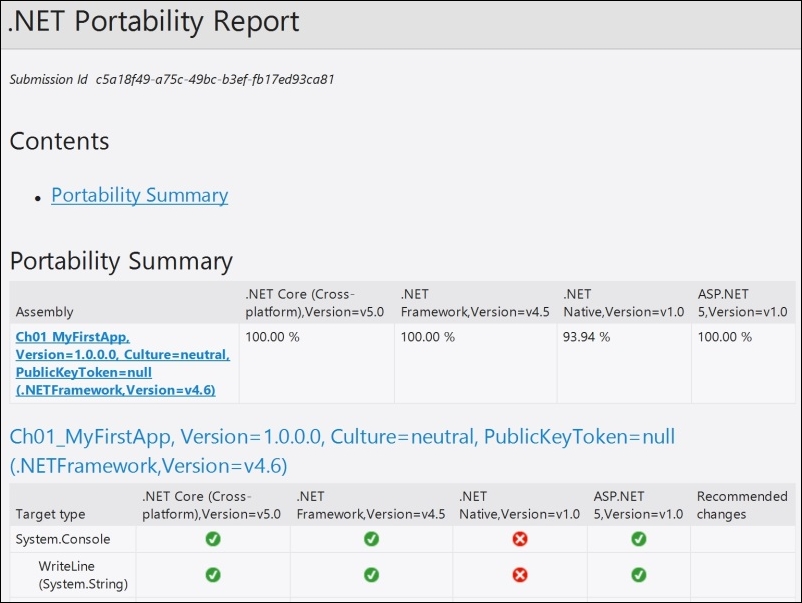
Note
At the time of writing this, the .NET Portability Analyzer has not been updated to show the new version branding for .NET Core and related products, which can be found at http://www.hanselman.com/blog/ASPNET5IsDeadIntroducingASPNETCore10AndNETCore10.aspx.
Press Ctrl + W, E to view the error list, which has also been populated. As we saw earlier, double-clicking on an error will jump the code editor to the line that could cause an issue:

I used the .NET Portability Analyzer while writing all the code in this book to ensure that, whenever possible, I can show you code that will work cross-platform using the .NET Core 1.0. If there are useful features that aren't cross-platform yet, then I will point that out in the text. Hopefully, they will be implemented in .NET Core in future versions.
Let's recreate the console application, but this time, target the .NET Core from the start.
There are two sets of command-line tools that you can use to manage the .NET Core:
.NET Version Manager, .NET Execution Environment, .NET Development Utilities (
dnvm,dnx,dnu): These were used by Microsoft during the initial development of the .NET Core between 2013 and 2015. They are installed as part of Visual Studio 2015. These tools will be deprecated with the final release of the .NET Core..NET CLI (
dotnet): This is a driver, which will be used by the final release of the .NET Core. It provides a simplified layer on top of other underlying tools. The .NET CLI must be installed separately.
Tip
At the time of writing, the DNX tools are more advanced than the .NET CLI, so in Chapter 15, Taking C# Cross-Platform, I will need to show you how to use both sets of tools. For this chapter, we can use the newer CLI tool because we are only using basic features. I recommend that you browse http://cs6dotnetcore.azurewebsites.net/ for information about changes between the time of writing this book and the release of the final versions of .NET Core 1.0 and its related technologies and tools.
First, we must install the .NET Command Line Tools (CLI).
Start Microsoft Edge and go to the https://github.com/dotnet/cli.
Scroll down the page to find the Installers section and click on the link to download the MSI file for Windows. Open the file and install.
Start the Developer Command Prompt for VS2015. At the prompt, enter the following command:
dotnet
You should see the following output:
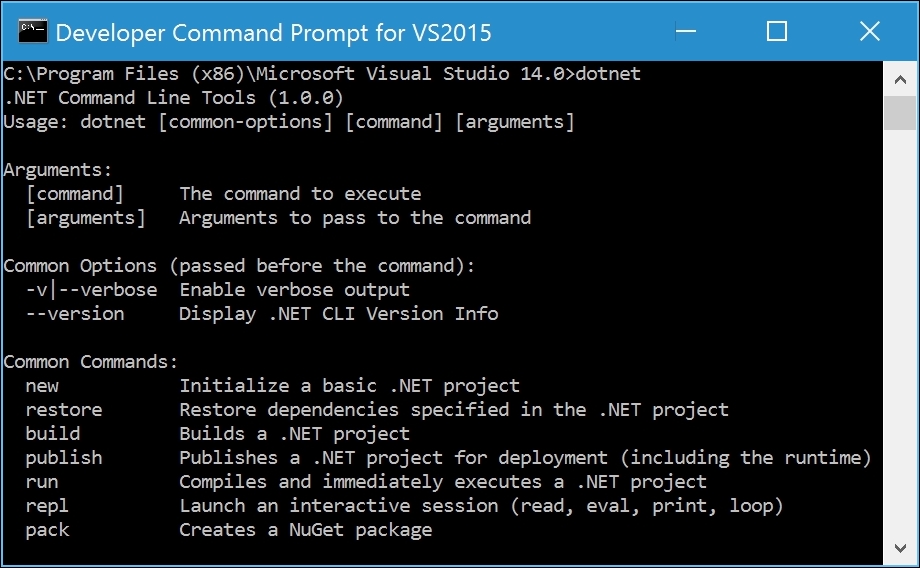
Enter the following at the prompt to create a new directory, change to it, create a new console application in the directory, and then list the files it created:
cd C:\Code\Chapter01 mkdir Ch01_MySecondApp cd Ch01_MySecondApp dotnet new dir
You should see that the dotnet tool has created three new files for you: NuGet.Config, Program.cs, and project.json.
At the prompt, enter the following to start Notepad for editing the Program class:
notepad Program.cs
In Notepad, modify the WriteLine statement as follows:
Console.WriteLine("Hello C#, Welcome .NET Core!");Save changes and exit Notepad.
At the prompt, enter the following commands:
dotnet restore dotnet run
After a few seconds, all the dependency packages will be downloaded and your application will run, showing the following output:
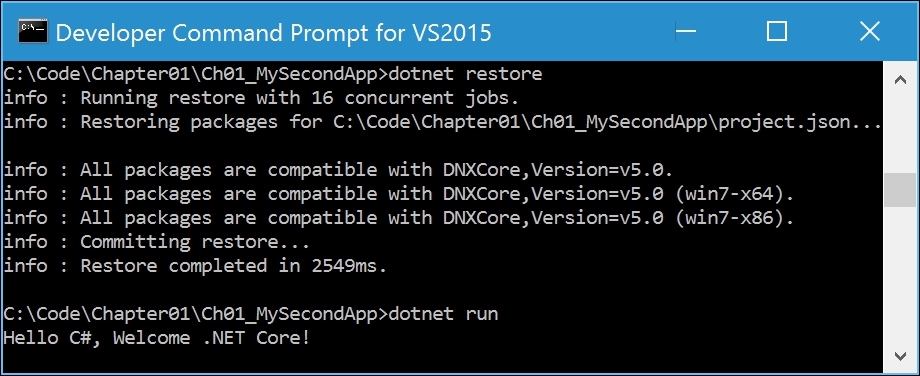
To compile the source code into an assembly containing IL code, enter the following command:
dotnet build
The output in the Command Prompt window should look like this:
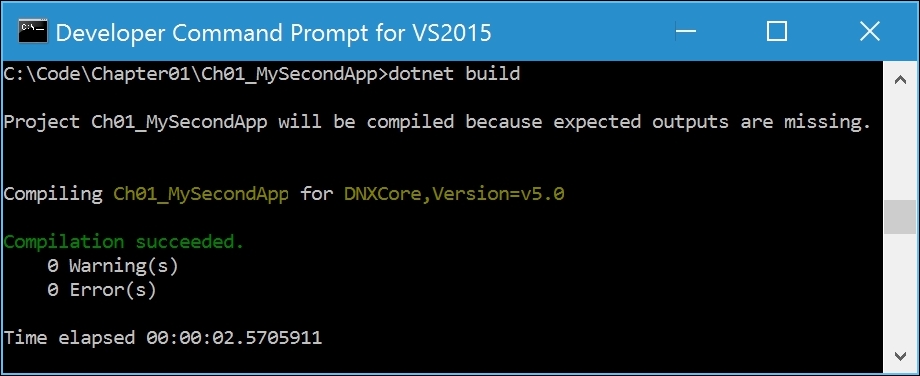
Enter the following commands to change to a subdirectory, list the files in it, and execute the compiled console application:
cd bin\Debug\dnxcore50 dir Ch01_MySecondApp
Start Visual Studio 2015 and open the Chapter01 solution.
In Visual Studio, navigate to File | Add | New Project.
In the Add New Project dialog box, in the Installed Templates list on the left-hand side, choose Visual C#. In the list at the center, choose Console Application (Package). Enter the name Ch01_DotNetCore, and click on OK or press Enter:
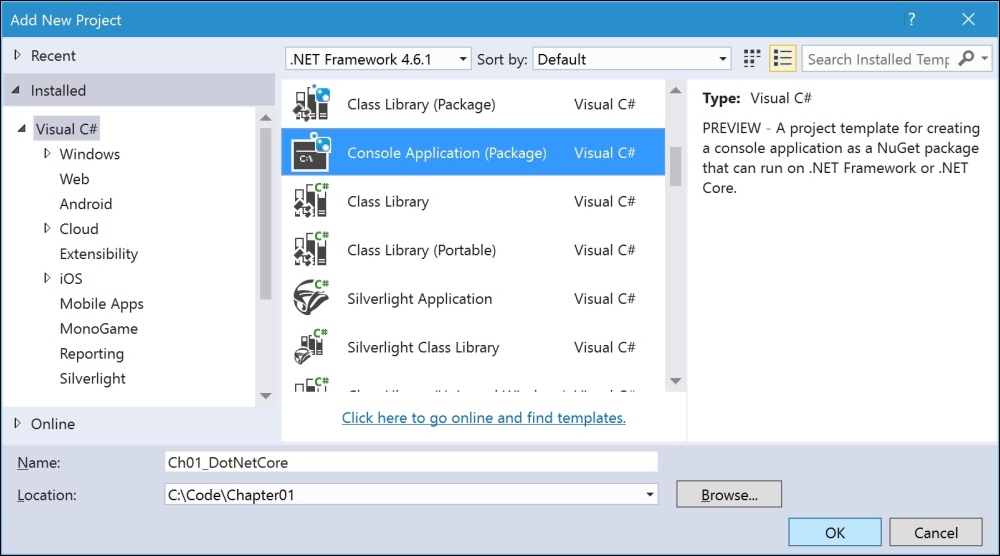
In the Solution Explorer window, right-click on the solution named Chapter01 and choose Properties.
Set the Startup Project to Current selection and click on OK.
Inside the Main method of the Program class, enter the following statements:
Console.WriteLine("Welcome, .NET Core!");
Console.ReadLine();As you type code, you will notice that Visual Studio shows you which types and methods might not be available when targeting .NET Core. For example, the BufferHeight property is available when targeting the .NET Framework but not the .NET Core, as shown in the following screenshot as DNX 4.5.1 and DNX Core 5.0 respectively:
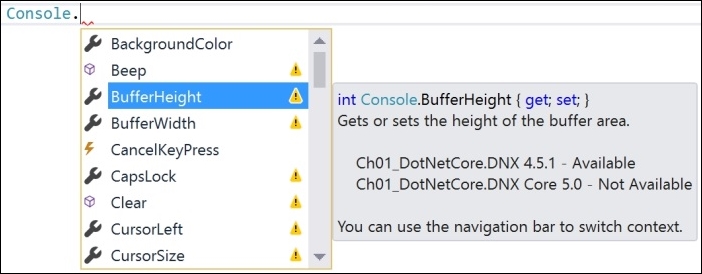
You can tell the compiler to include statements available only when .NET Framework is available by using conditional compilation symbols, as follows:
#if DNX451
Console.BufferHeight = 300;
#elseif DNXCORE50
// some alternative for .NET Core
#endifTip
In Chapter 5, Using Specialized .NET Types, you will learn more about conditional compilation symbols so that you can create projects that target both the .NET Framework and the .NET Core with a single code base.
Note
The names of the conditional compilation symbols will change in the future. Visit https://github.com/dotnet/corefx/blob/master/Documentation/architecture/net-platform-standard.md for more information.
In the Solution Explorer window, double-click on Properties for the Ch01_DotNetCore project.
In the Properties window, click on the Debug tab, select the Use Specific Runtime checkbox, and select the latest version of the .NET Core platform for the x64 CPU architecture, as shown in the following screenshot:
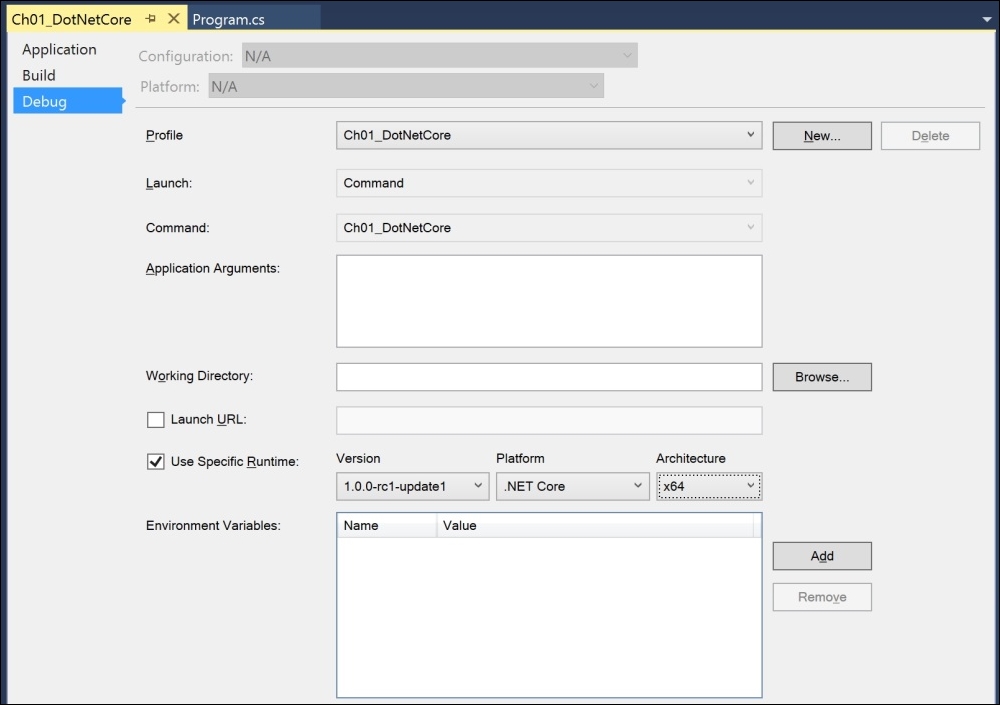
In the Visual Studio Debug menu, choose Start or press F5.
Note that the Command Prompt window shows that the console application is running the dnx-coreclr-win-x64.1.0.0-rc1-update1 runtime:

Git is a commonly used source code management system. GitHub is a company, website, and desktop application that makes it easier to manage Git.
Visual Studio 2015 has built-in support for using Git with GitHub as well as Microsoft's own source code management system, named Visual Studio Team Services.
I used GitHub to store solutions to all the practical exercises at the end of each chapter.
In Visual Studio, navigate to View | Team Explorer menu to see the Team Explorer window:
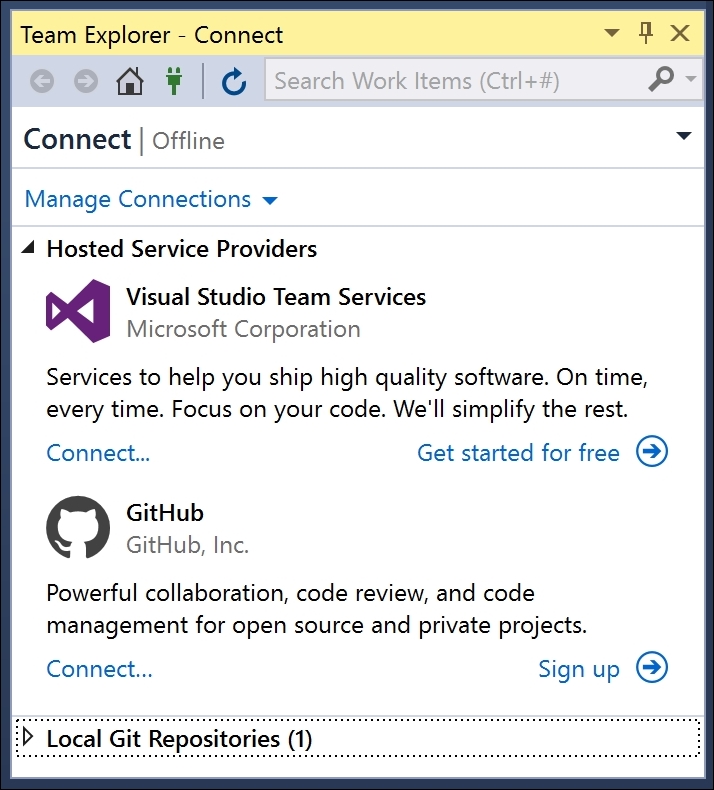
Although it is a good idea to sign up with an online source code management system provider, you can clone a GitHub repository without signing up for an account.
In the Team Explorer window, expand Local Git Repositories, click on the Clone menu, and then enter the following URL of a Git repository to clone it:
https://github.com/markjprice/cs6dotnetcore.git
Enter a path for the cloned Git repository:
C:\Code\Repos\cs6dotnetcore
Click on the Clone button:
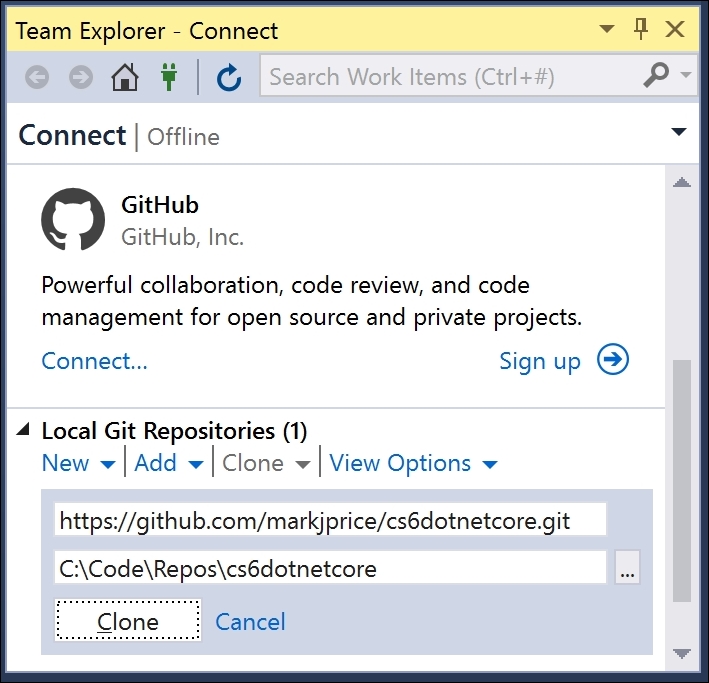
Wait for the Git repository to clone locally:
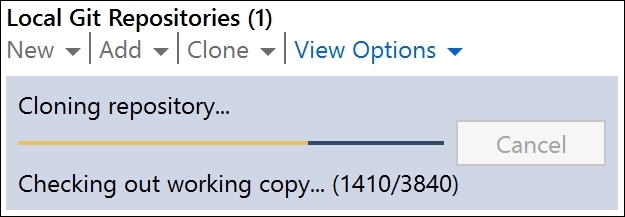
You will now have a local copy of the complete solutions to all the hands-on practice exercises for this book.
Test your knowledge and understanding by answering some questions, get some hands-on practice, and explore, with deeper research into the topics covered in this chapter.
Answer the following questions:
Why can a programmer use different languages to write applications that run on .NET?
What do you type at the Command Prompt to compile the C# source code?
What is the Visual Studio 2015 keyboard shortcut to save, compile, and run an application, without attaching the debugger?
What is the Visual Studio 2015 keyboard shortcut to view the error list?
What does
ildasm.exedo?Is the .NET Core better than the .NET Framework?
How is .NET Native different from the .NET Core?
What does the .NET Portability Analyzer do?
What is the difference between Git and GitHub?
What is the name of the entry-point method of a .NET application and how should it be declared?
Practice closing and viewing windows, such as Error List and Toolbox.
You can pin, unpin, float, and rearrange windows by dragging their title bars. As you do so, Visual Studio will show blue tinted boxes and overlays to help you to understand where the window will be moved when you release the mouse button.
You do not need Visual Studio to practice writing C#. Simply go to the .NET Fiddle website (https://dotnetfiddle.net/) and start coding. It's also a great way to share snippets of C# code with other developers:

Use the following links to read more details about the topics covered in this chapter:
Visual Studio IDE User's Guide: https://msdn.microsoft.com/en-us/library/dn762121.aspx
Solutions and Projects: https://msdn.microsoft.com/en-us/library/b142f8e7.aspx
Using IntelliSense: https://msdn.microsoft.com/en-us/library/hcw1s69b.aspx
Identifying and Customizing Keyboard Shortcuts in Visual Studio: https://msdn.microsoft.com/en-us/library/5zwses53.aspx
Making your libraries compatible with .NET Core and other .NET Platforms: https://github.com/dotnet/corefx/blob/master/Documentation/project-docs/support-dotnet-core-instructions.md
.NET Core: A general purpose managed framework: http://dotnet.github.io
Leveraging existing code across .NET platforms: http://blogs.msdn.com/b/dotnet/archive/2014/08/06/leveraging-existing-code-across-net-platforms.aspx
.NET Command Line Interface (CLI): https://github.com/dotnet/cli
Use Visual Studio and Team Foundation Server with Git: https://msdn.microsoft.com/Library/vs/alm/Code/git/overview
The easiest way to connect to your GitHub repositories in Visual Studio: https://visualstudio.github.com/
In this chapter, we set up the development environment, we used the Developer Command Prompt to compile and decompile an application, we used Visual Studio to create the same application and explore the features that make it so easy to use for development, and we discussed the differences between the .NET Framework, the .NET Core, and .NET Native.
In the next chapter, you will learn to speak C#.























